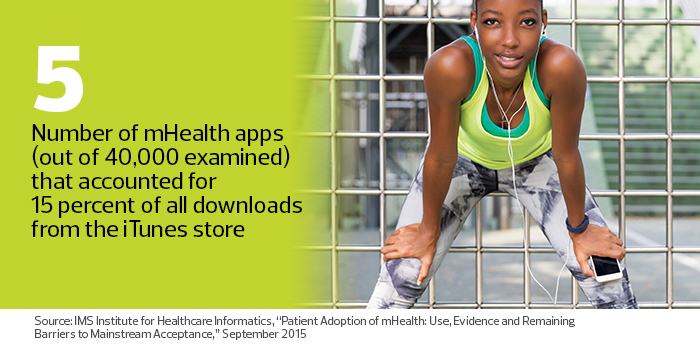How to Build Better mHealth Apps
The influx of innovations in mobile and digital solutions to facilitate healthy behavior and improve health outcomes is enormous. Analysts estimate that this ever-growing technology comprises about 165,000 apps, alongside hundreds of text-based, social media and web-based initiatives.
All of these tools offer individuals and their care providers opportunities to improve and sustain healthy behaviors and good health. A major problem with the vast majority of mHealth solutions, however, is that we don’t know whether they actually work.
Challenges Persist in Evaluating mHealth Success
Does it count as working if people simply download and use an mHealth solution? While I would argue that represents an exceptionally low bar for performance, difficulties persist to reaching even that threshold.
Of more than 40,000 mHealth apps recently examined (available now through the iTunes store), 50 percent have been downloaded fewer than 500 times. What’s more, just five apps account for 15 percent of all downloads, and the mean number of opens for each of those apps is one.

Our track record, therefore, is very poor, even if we consider that an app or other mHealth solution works simply because it is downloaded and used.
Discovering Evidence of mHealth Effectiveness
Still, a small but growing body of evidence demonstrates that text messages effectively facilitate healthy behaviors such as medication adherence and compliance with healthcare appointments. And our own work at the mHealth Impact Laboratory at the University of Colorado Denver shows that text messages boast the potential to help teens avoid pregnancy.
This evidence extends to efforts to promote health and manage disease via social media, and recently demonstrates that apps can be used to impact self-management of chronic illness, such as diabetes.
In a crowded and competitive market, developers add value when the tools created do all they can to impact health behaviors and health outcomes. Hopefully, with some diligence and attention to your users, you can contribute effective and impactful mHealth solutions to this dynamic field.
1. Focus on an Actual Problem
Heart disease, cancer, stroke, diabetes and kidney disease are chronic conditions that rank among the leading causes of death. An estimated 84 percent of all healthcare spending is focused on the 50 percent of U.S. adults who have one or more chronic conditions.
Much of this morbidity and mortality comes down to four health risk behaviors: lack of exercise or physical activity, poor nutrition, tobacco use and excessive alcohol consumption. Focusing on one of these can be key to improving public health.
2. Build a Back End to Your Tool
When you begin to code, make certain that you have a back-end database that will track user experience and document where they spend their time in your app or in completing your program. Without this, you cannot demonstrate what elements of your program work.
At a minimum, you should track logins and click trails, as well as time spent on each page and on each task.
3. Pay Attention to the User Experience
Attention to the user interface and user experience is impactful. Less is more, and simplicity and elegance rule over complexity.
Your tool should be easy to understand, use and navigate. Get your audience to try out the tool — as many times as necessary — in order to assure yourself that they can and will use it.
4. ID a Target Audience
Once you identify the problem you want to address, consider whom you can reach for maximum impact. Specific attention is needed to develop solutions for those facing disparities when managing their chronic conditions, particularly low income and minority populations. Good evidence exists that adapting and creating solutions that are culturally tailored for diverse groups can be helpful in increasing their effectiveness.
5. Push for Early Feedback
Once you figure out who can benefit from your solution, talk to them. Set up a discussion board online, meet them faceto face, interview them in groups — whatever works to get their input is valuable.
Talk to them before you code to get their feedback on your idea. Find out what would help them to improve their health. Would they use your tool? Why or why not?









